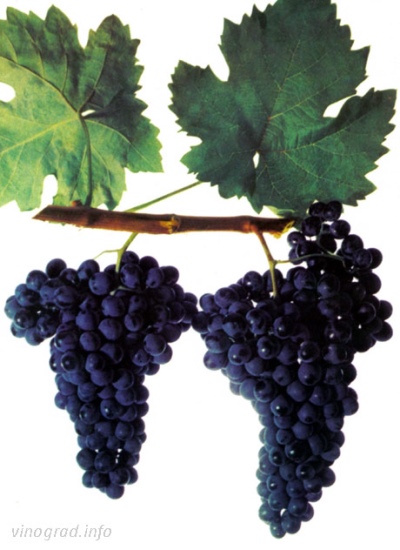
- Authors: N.V. Paponov, VNIIViV Magarach
- Appointment: technical
- Berry color: dark blue, covered with thick prune
- With bones: Yes
- Ripening period: mid-late
- Ripening period, days: 146
- Name synonyms: Magarach No. 217
- Bunch weight, g: 176
- Yield: 107,1
- Flower type: bisexual
Bastardo Magarachsky grapes are very popular among the production of alcoholic beverages. Delicious wines, port and many other drinks are made from it, in the production of which grapes are used.
Breeding history
The technical grape Bastardo Magarach was bred by the Ukrainian breeder N.V. Paponov in the laboratory of VNIIViV Magarach thanks to the crossing of two varieties: Bastardo and Saperavi. The variety also has a lesser known name - Magarach No. 217.
Geography of distribution
The vineyards of this variety cover a huge number of countries: Portugal, Russia, France, Belarus, Moldova and, of course, Ukraine - the country in which it was born.
Description
The variety has a pubescent white crown with a raspberry border. Shoots are light brown. Leaves are medium dissected, rounded. The lower surface is covered with light fluff.
Ripening period
The ripening process of Bastardo Magarach is not so fast: the average variety takes about 146 days. It is grown mainly in the sunniest regions.
Bunches
The cluster is medium in size, has a cylindrical-conical or conical shape with blades. Its weight is very small: it is only 176 grams.
Berries
The grapes located on a bunch are oval in shape. They grow both small and medium in size. They are 15.5 mm long and 12 mm wide. The crust of a pleasant dark blue color is covered with a thick waxy coating, which makes the grapes appear dull. There are 2-4 seeds in the berry.
Taste
The variety has a sweet taste and a thin crust, but it is problematic to chew. The flesh has a delicate greenish color and is usually very juicy and soft. Doesn't have any aroma.
Yield
One hectare of land accounts for 107.1 centners of berries. This is a medium-yielding variety.


Growing features
The cultivation features depend on the region in which the grapes grow. They are determined by the fertility and density of the land, as well as the moisture or aridity of the region.
Landing
Bastardo Magarach is a rather sun-loving variety. He needs abundant heat and drip irrigation. The variety prefers fertile soils. Before planting in the spring, it is necessary to trim the shoots at soil level, but if the grapes are grown in a greenhouse, then the cut must be performed 2 buds higher. At the end of spring, the planted seedlings are checked for survival: if there are dried ones, they are removed along with the buds.

Pollination
Pollination is not required for this variety, since Bastardo Magarach has a bisexual flower.
Pruning
During autumn pruning, when forming a low stem, 8-10 eyes are left on the vine. With a high stem, 5-6 eyes should remain.

Watering
Abundant watering of Bastardo must be done 4 times per season:
- at the very beginning of flowering;
- before the formation of ovaries;
- in the process of growing bunches;
- before the cold snap.


Top dressing
The variety almost does not need organic fertilization, but during flowering and fruiting, it is necessary to feed the soil with nitrogen 2 or more times per season. When the fruits are already ripe, phosphate feeding is used. Mineral is used as needed (it can be judged by the appearance of the bush).
Frost resistance and the need for shelter
The variety has medium frost resistance. Withstands temperatures from -19 to -20 degrees.

Diseases and pests
The grapes are moderately resistant to all sorts of diseases and pests. It becomes most vulnerable with abundant moisture and cold ground temperatures. In such conditions, the variety has a high risk of gray rot. To prevent the occurrence of harmful insects, Bastardo should be treated with insecticides before flowering.

If a grape is exposed to any disease or insect, this always affects its appearance.
Storage
At home, the variety can be stored for no more than a week. If the deadline is exceeded, the grapes must be thrown away immediately. Under appropriate conditions and cool temperatures, the shelf life of the grapes can be extended to six months.











































































